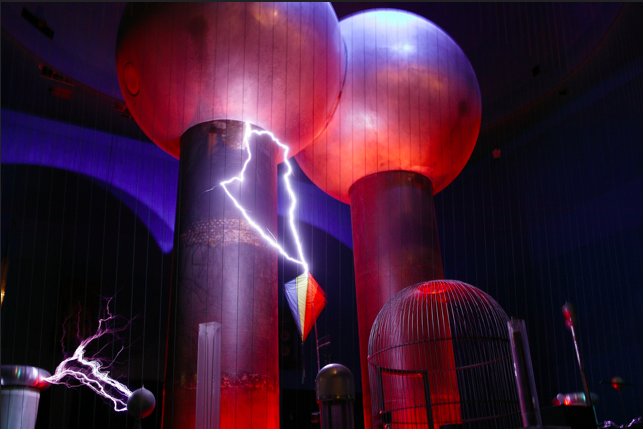by Jessica Hoffman

Two large metal mushrooms loomed above me, barely obscured by the thin shield of wiry threads fencing them in. The room glowed with an otherworldly light. The air crackled with spiraling energy. Suddenly, the loudest noise I’d ever heard pierced my ears as a white-hot jagged beam of magic erupted from the machine, cracking rhythmically against the metal.
The Museum of Science was making lightning again.
It’s the first school trip I can remember. I don’t know how old I was. I don’t remember much else about the museum (other than grade schoolers arguing about the merits of astronaut ice cream.) I don’t even remember much else about the show. But years later, I can still hear the humming and the cracks. I can still feel the anticipation and fear humming through my body. I can still remember how bright it was. How beautiful and how terrifying.
Boston’s Museum of Science tries to be as interactive as possible. The lightning shows are one of the rare moments when visitors must sit, watch, listen, and most definitely not touch anything. They are also one of the Museum’s evergreen showstoppers.
The shows are a demonstration of the world’s largest Van de Graff generator: 40 feet high and over 80 years old. It was built in 1933 at MIT but, after technology moved on, the generator moved as well, relocating to the Museum as a permanent exhibit and a field trip staple for most Massachusetts school children.
The Museum puts on hundreds of lightning shows a year, thrilling and terrifying people of all age groups. In keeping with the spirit of the Museum, the exhibit is a practical and approachable demonstration. Shows last for 20 minutes and use clear language — science for everyone. Presenters use fancy scientific words, but also explain concepts in clear ways that relate to our everyday lives. Which, in turn, allows us to understand the basics of electric current without a physics degree or hours watching science documentaries.
Most importantly, it is memorable, not only because of the lightning crashes, but because of the presentation. The show not only teaches us about electricity with words, it also shows us practical demonstrations. Using tools like light bulbs, props like child volunteers, and humor, the presenters explain core concepts of electricity such as conductors, current, and why we won’t get electrocuted if we stay inside our cars.
The exhibit impressed on me at an early age some core concepts. Science doesn’t need to be scary. It can be fun. The same holds true for other types of museum exhibits. Not everything can be participatory. Not everything can be a blockbuster or a spectacular show. But every exhibit, if done right, can take a topic that might seem boring or dry and make it fascinating. We just need to find a way to make people not only understand what they are learning, but care and take it away with them.
Good storytelling transcends age groups and interests. If we present our stories in compelling ways, if we talk to our audiences in clear voices, if we talk and write and exhibit for the everyman, not the archivist or curator, we expand our reach. We can’t talk down to people and treat them like they don’t belong in our world. Nor can we terrify them with complicated jargon. But if we tell good stories and reach out — even to caged audiences of elementary school kids intimidated by the topic — some will listen.
Years later, the Museum of Science has always remained one of my favorite places in town and the place I’m most likely to recommend to tourists. Because I remember my experience there. I remember the joy and wonder. And I trust that the Museum will allow others to experience those same feelings.
I moved back to Boston last year and returned to the Museum for the first time in years in the middle of the winter. My science reporter best friend in tow, we explored every inch of the exhibits, playing with all the exhibits with abandon and learning new ways to look at things. We hadn’t budgeted the lightning show into our visit, but we still snuck in near the end. And while I might be years older, while I might understand the science behind the magic, the spectacle hasn’t dimmed.
